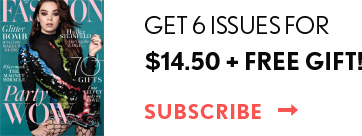While most celebrities faltered or leaned into loosely connected interpretations, some African stars at the Met Gala pulled off fanciful interpretations of the theme by grounding their looks in continental aesthetics.
By Abioye Damilare Samson
The 2025 Met Gala came with a theme that felt deeply rooted and refreshingly specific: “Superfine: Tailoring Black Style”. Inspired by Barnard professor and author, Monica L. Miller’s 2009 book, “Slaves to Fashion: Black Dandyism and the Styling of Black Diasporic Identity”, this year’s exhibition and dress code explored 300 years of Black dandyism, a style movement that blends elegance, individuality, and resistance through fashion. It was a celebration of how Black people, across centuries and continents, have used tailoring, colour, and flair as a form of identity, pride, and protest.
Naturally, expectations were high for African stars and designers. If there’s any region where fashion has long been used to signal class, culture, and confidence, it’s the African continent. From the exuberance of Congolese sapeurs to the sharp lines of Senegalese tailoring and the grand presence of Nigerian agbadas, African fashion already lives within the spirit of Black dandyism. The hope was that this year’s Met Gala would reflect that.
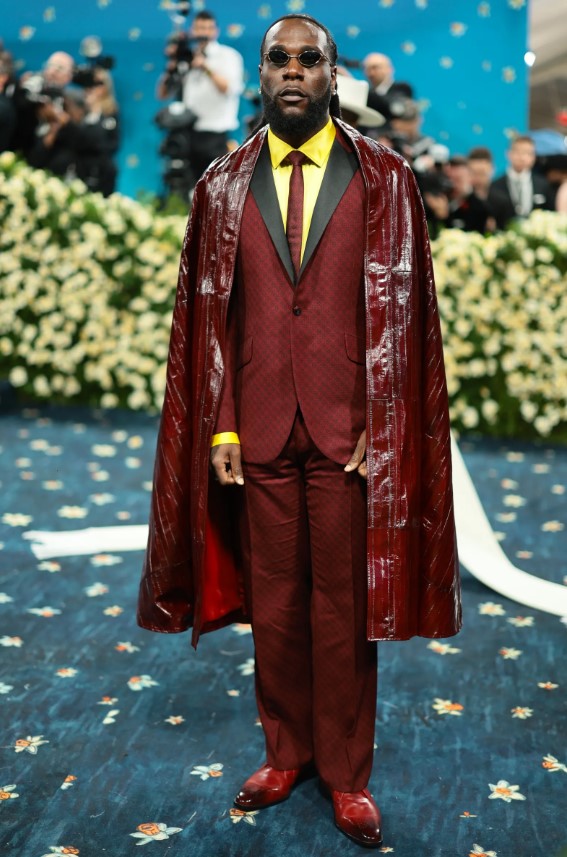
Some attempts stood out: Tems in a dramatic, umbrella-accented look by Ghanaian-British designer, Ozwald Boateng; Burna Boy in a lush, richly textured suit; Chimamanda Ngozi Adichie in an opulent red ball gown; and Ayo Edebiri in a minimalist yet symbolic dress that nodded to her Benin roots. While designers like Ozwald Boateng, Ugo Mozie, Chuks Collins, and Hanifah made waves, the night also highlighted a gap in fully grounding Black dandyism in African cultural practices.
In this piece, we break down some of the significant takeaways from Africa’s presence at the Met Gala 2025, from the standout moments of representation to the missed chances, and how a more culturally rooted approach might have transformed the night.
The African Designers Who Shaped the 2025 Met Gala
If there was any moment to spotlight the brilliance of African designers on a global stage, it was the 2025 Met Gala. With a theme that explored deep into the cultural and political layers of Black fashion, it was only fitting that a vibrant mix of designers from across the continent and the diaspora took their rightful place at fashion’s biggest night. And this year, they did with confidence, cultural pride, and couture-level skill.
British-Ghanaian tailoring legend, Ozwald Boateng, was arguably the night’s most visible African designer, both on and off the carpet. His richly detailed, suiting-forward aesthetic was not only central to the Costume Institute’s “Superfine: Tailoring Black Style” exhibition, but also framed the sartorial presence of multiple celebrities.
Ozwald Boateng’s work showed up on the bodies of Burna Boy, Tems, Jaden Smith, Henry Golding, and Colin Kaepernick, each styled in custom pieces that reflected the depth and texture of African heritage.
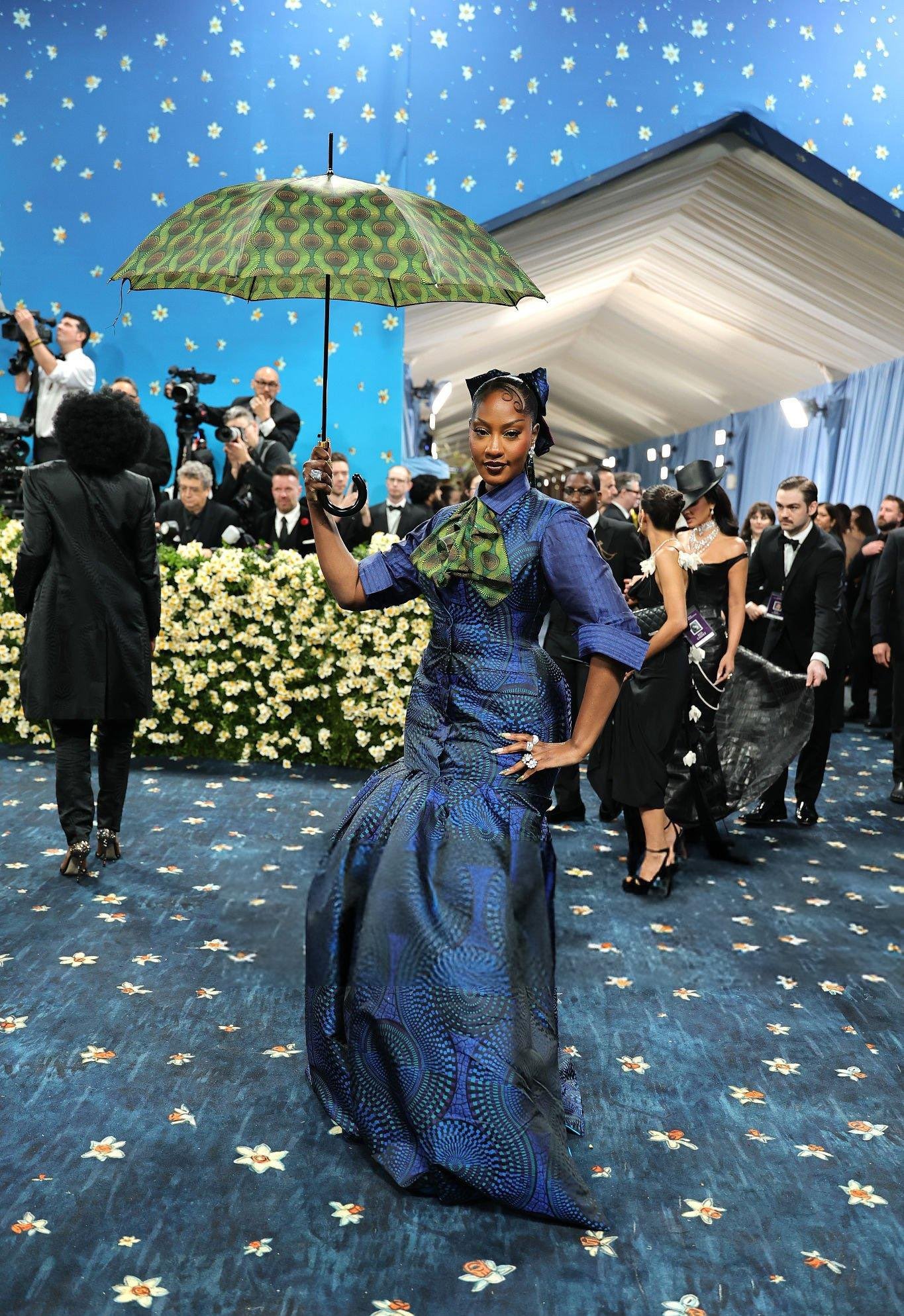
Nigerian design duo, Deji & Kola — founded by Ayodeji Adebayo and Kolapo Olabintan — brought their distinctive touch to the night with custom pieces worn by NFL player, Jonathan Owens, and media entrepreneur, Claire Sulmers, adding to the evening’s cultural richness.
They were joined by other creative designers like Ugo Mozie, Chuks Collins, Hanifa (the label led by Congolese-American designer Anifa Mvuemba), and Adebayo Oke-Lawal’s Orange Culture, which crafted a striking red two-piece suit paired with a white shirt, long black tie, and a textured red-and-gold coat for American actor, Brian Tyree Henry. From West to Central to Southern Africa, the continent’s presence was also felt through South African designers like David Tlale and Thebe Magugu, ensuring that Africa’s sartorial identity resonated across the Met Gala’s blue carpet.
Amid the dominance of legacy fashion houses and European heritage brands, the African designers on display expanded the possibilities of what Met Gala fashion can be when it’s grounded in culture, storytelling, and a refusal to conform to traditional Western silhouettes.
The Missed Opportunity to Ground Black Dandyism in African Tradition
For a theme that set the stage so clearly as “The Concept of the Black Dandy”, the 2025 Met Gala left much to be desired, particularly in how the African continent’s rich sartorial history was sidelined or rather, simplified. There was a widespread expectation that this global celebration of Black tailoring would lean into African interpretations, or at the very least, extend a respectful nod to the continent that so often serves as fashion’s subconscious moodboard. Instead, many of the night’s looks veered off-theme, and the opportunity to reframe Black dandyism through Africa’s visual traditions felt, at best, underexplored.
Few traditions embody dandyism in its boldest, most defiant form like “La Sape—La Société des Ambianceurs et des Personnes Élégantes” rooted in the twin cities of Brazzaville and Kinshasa. Born out of colonial mimicry and later turned into an act of stylish resistance, La Sape’s vibrancy, bright European suits, exaggerated tailoring, and deliberate excess speak directly to the spirit of the theme. This was an aesthetic primed for the Met’s blue carpet, but not fully explored.
The Yoruba agbada tradition, too, offers an expansive canvas for reinterpreting the Black dandy. In its most regal form, agbada is power and poise: voluminous robes embroidered with cultural motifs, styled with coral beads, sculpted caps (fila), and custom leather footwear. This is tailoring with story, with ceremony, and it reveals the very essence of what this year’s exhibition aimed to showcase: Black style as identity, resistance, and flair.
Even Senegalese kaftans, minimalist but meticulously stitched, often paired with embroidered slippers and tasseled caps, carry a subdued yet striking take on dandyism. Each of these traditions could have offered a richer, more grounded reading of Black elegance beyond the Western suit. Instead, the night saw more Western references than was necessary.

As one user posted on X (formerly Twitter): “Sydney Sweeney referencing Kim Novak, a white lady, for superfine tailoring black style….ok?” Another commented, “Them non black people really weren’t on theme at all like the theme is ‘Superfine: Tailoring Black Style’ you paying homage to a white person ??????”
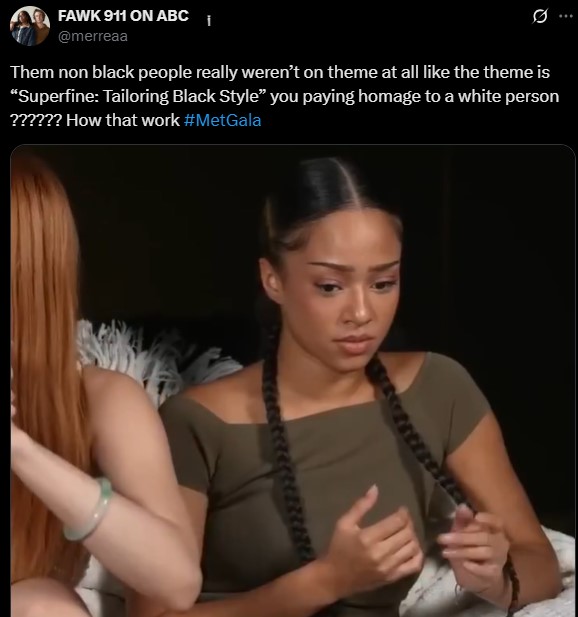
Of course, there were moments of brilliance. A few attendees embraced the theme with thoughtful styling and cultural specificity. However, a widespread embrace of African sartorial language could have made the Met Gala not just stylish but historically and culturally resonant.
On Theme and On Point: The Africans Who Understood the Assignment
Despite a night that mostly danced around the theme of “Black dandyism”, a handful of African stars and creatives showed up with clarity, conviction, and couture that honoured the theme and embodied it.
One of the most powerful statements came from Nigerian author and one of Met Gala 2025 host committee members, Chimamanda Ngozi Adichie. Draped in a cherry-red regal ensemble designed by Prabal Gurung, Adichie channelled flamboyance and intellect in equal measure. The outfit’s commanding silhouette and unapologetic boldness reflected the very spirit of the Black dandy.
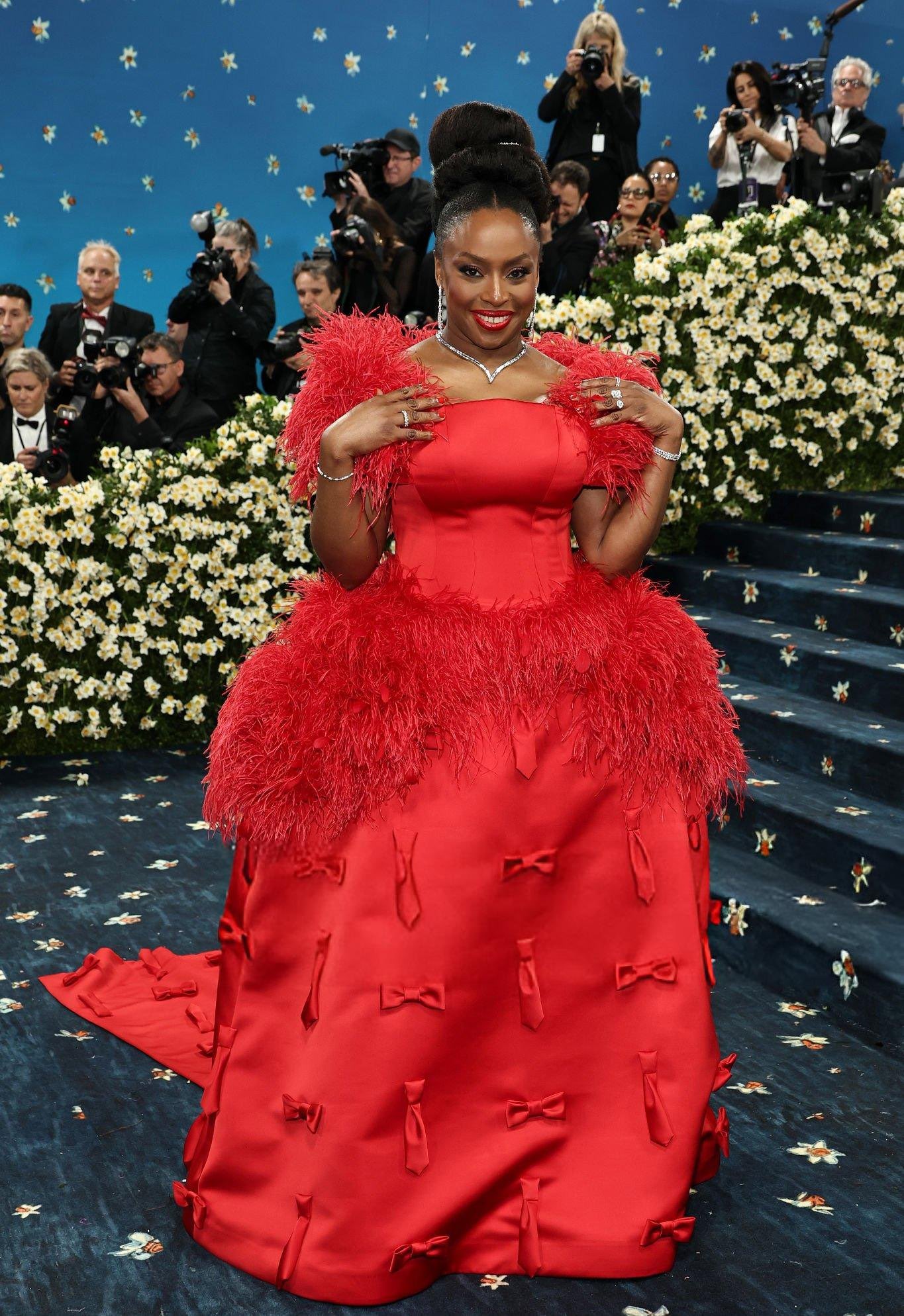
Tems was another of the night’s undeniable standouts. Styled in a custom blue Ankara suit dress, she merged elegance and attitude, pairing a voluminous puff skirt with a green cravat and a matching umbrella.
Her look pays homage to the flamboyant flair of the Black dandy while staying rooted in African textures and silhouette. As she told Harper’s Bazaar, “I feel like this was the perfect union… [Boateng] defines everything that Black excellence is to me”. The styling was thoughtful, the tailoring sharp, and the symbolism unmistakable.
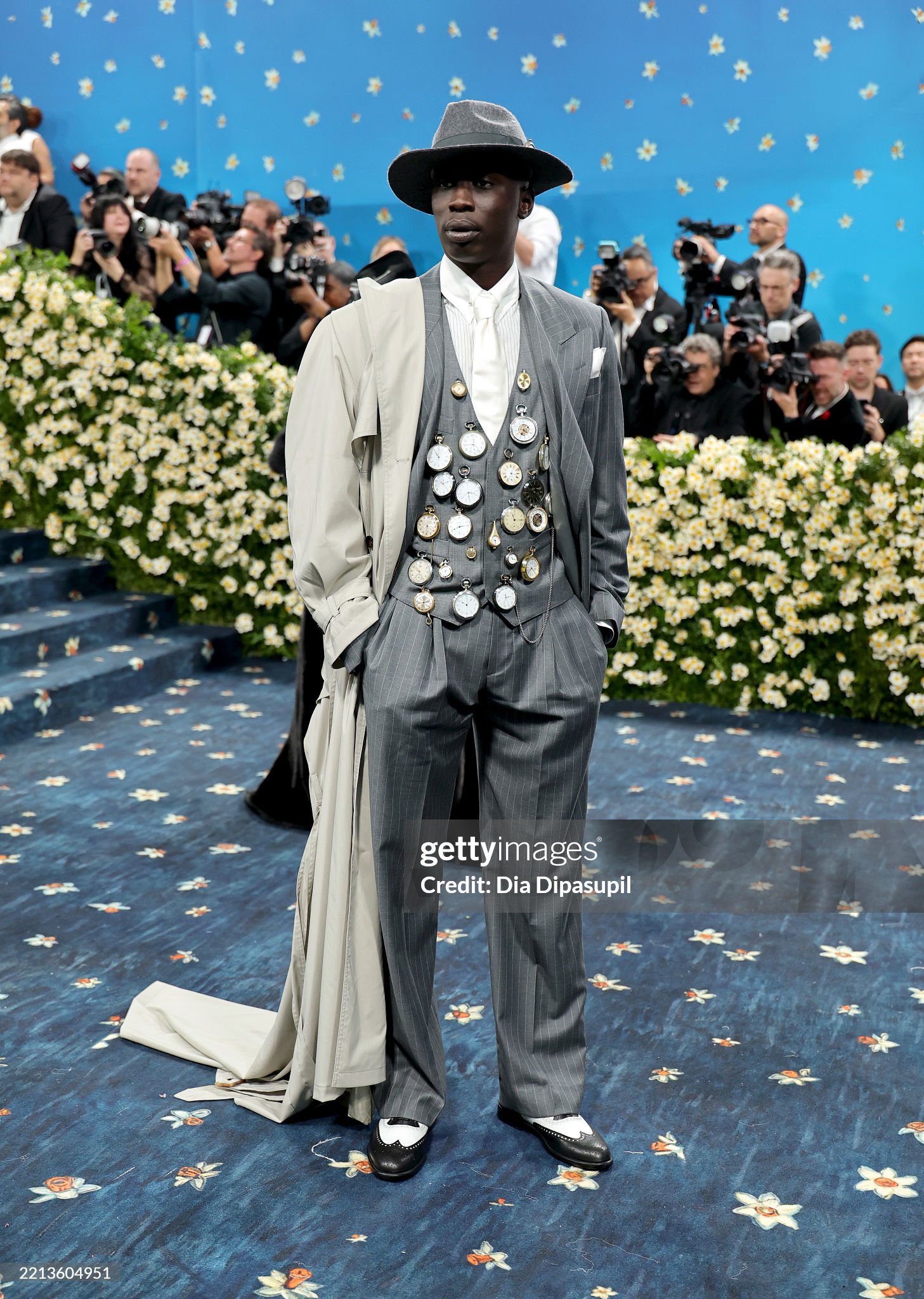
Senegalese-Italian influencer, Khaby Lame, also delivered a head-turning look in an archive-inspired grey pinstripe zoot suit by BOSS. With its origins in the 1940s as a symbol of cultural pride and political expression within the Black American community, the zoot suit was a perfect historical match for the Gala’s theme. Layered with a classic trench coat and accessorised with numerous pocket watches, Lame’s outfit fused theatricality with intention that is a nod to dandyism’s roots.
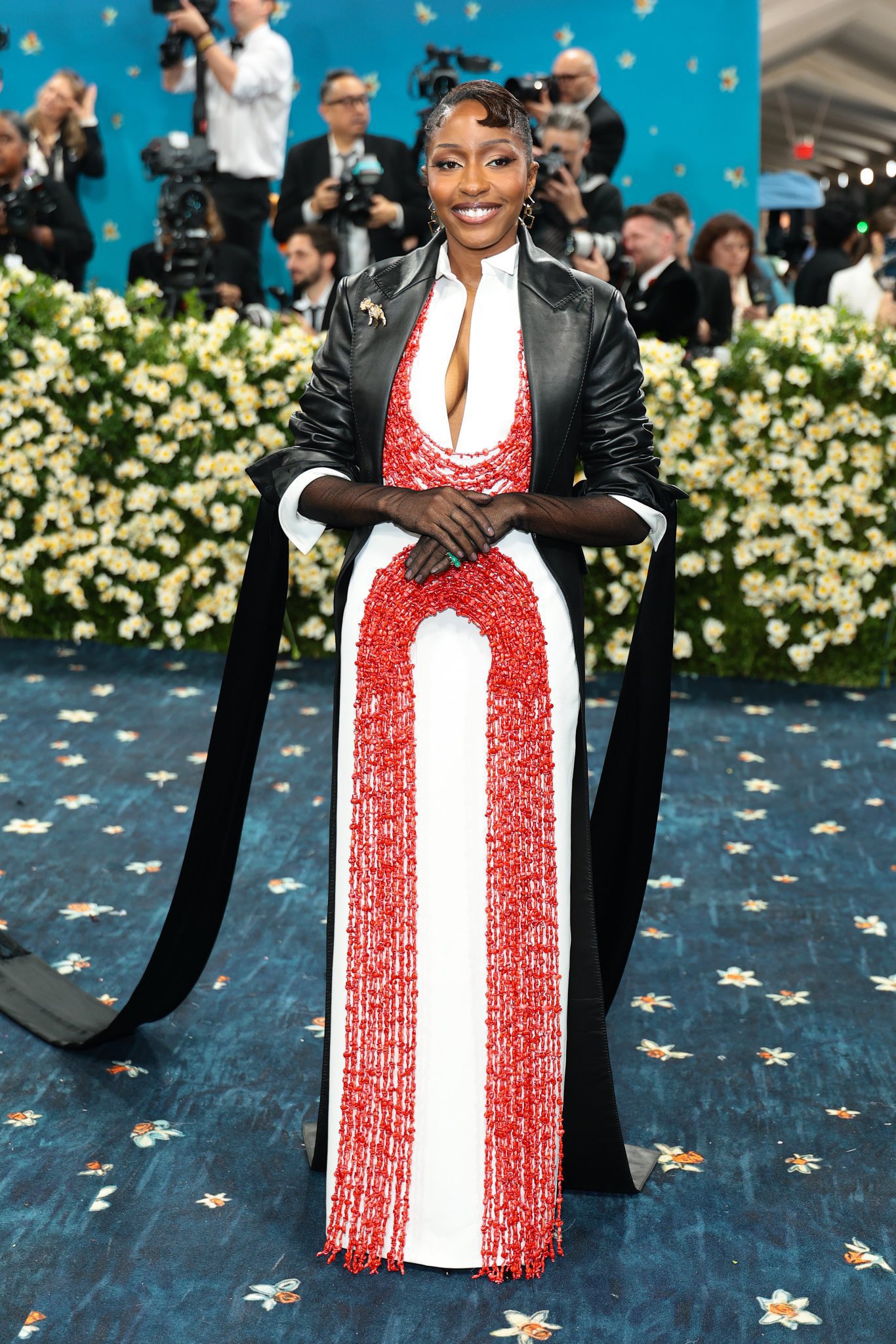
Ayo Edebiri delivered a beautiful homage through her white floor-length shirtdress, adorned with two arcs of red beads as an intentional nod to traditional Benin attire. While others faltered or leaned into loosely connected interpretations, some African stars understood the assignment by grounding their looks in African aesthetics that align with the theme and expanded its meaning through authentic expressions of Black dandyism.
Abioye Damilare is a music journalist and culture writer focused on the African entertainment Industry. Reading new publications and listening to music are two of his favourite pastimes when he is not writing. Connect with him on Twitter and IG: @Dreyschronicle

